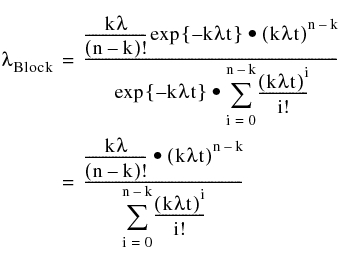Standby Redundancy
The reliability of standby redundancy with switch delays is calculated using simulation. If Switch delays treated as failures is selected (default) under RBD in the System file properties, the block is considered to be failed during the switch delay. If this checkbox is cleared, the delay caused by the switchover is not considered as a failure. However, it is considered as downtime for the purpose of availability. This is always the case, regardless of whether Switch delays treated as failures is selected or cleared. For more information, see RBD System File Properties.
When there are no switch delays, the following equations are used for standby redundancy with a switch probability of success of 1 and a standby failure rate of 0.



MTTF Block is not equivalent to  if if  . . |
Example
The following example for a 1-out-of-2 standby system illustrates the methodology used when taking into account the switching probabilities for standby units. Similar formulae are used for a k-out-of-n standby system. Let A and B represent two systems with A in operation and B in standby.
Let λ S be the failure rate of B when it is in the standby mode. The two mutually exclusive events leading to system success are:
• Event-1: The main unit does not fail in the interval (0, t).
• Event-2: The main unit fails at τ < t, the standby unit has not failed at τ, and the standby unit does not fail in the interval (τ, t).
Accordingly:


Adding the reliabilities of events A and B and introducing the switch probability of success (P S ), the system reliability is obtained:
